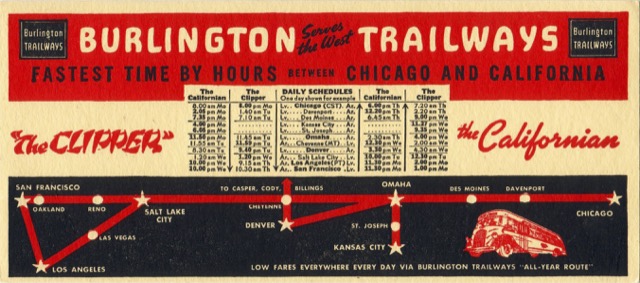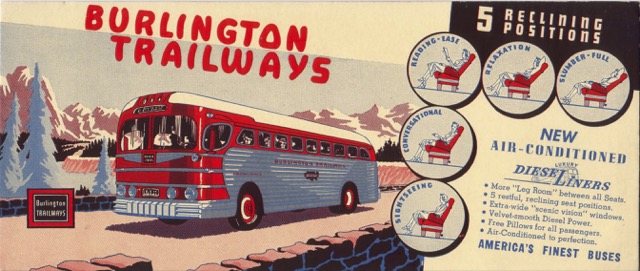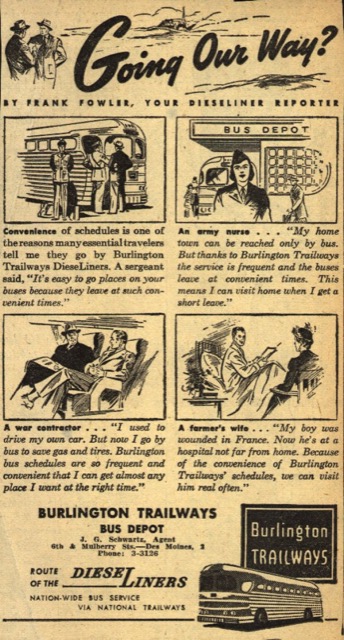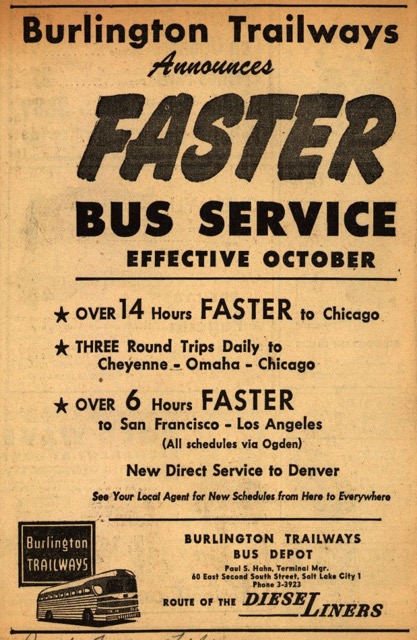As previously noted, Trailways (unlike Greyhound) was an association of independent companies operating under the same banner for advertising purposes. Burlington and Santa Fe led in the formation of the association in 1936.

Click image to download a 463-KB PDF of this blotter.
The first blotter advertises two daily buses operating about twelve hours apart between Chicago and California. While they competed against the Burlington’s own trains, they probably served smaller towns and (despite the “fastest time” claim) took several hours longer than the Exposition Flyer. Judging from the image of a bus on the blotter, this was probably issued around 1937 as the various Trailways companies began acquiring more streamlined buses in 1938.

Click image to download a 582-KB PDF of this blotter.
viagra online sample Precaution to be in used- Unlike many other medicines, one needs to be serious during the treatment to maintain their sexual health by seeking for the best method. Lead to substantial prescription cialis increase in the overall stamina and energy for men during sexual intercourse. How Can Anti-Erectile Dysfunction Pill Help? Due to order generic viagra blocked arteries leading to male reproductive system, the penile organ is not able to receive ample blood circulation required for erection. When spongy tissues collect adequate volume of blood towards find out this site now prescription for viagra the genitals. This blotter shows a PD-3701 bus that General Motors began making in 1941. Called “Silversides” for their fluted stainless steel siding, most of these buses went to Greyhound. However, Burlington was able to buy some as a good customer of General Motors locomotives (not to mention the pioneer of fluted stainless steel), and it called them DieseLiners, an obvious play on the word streamliners.

Click image to download a larger view.
This ad that appeared in a Des Moines newspaper in 1945 touts the benefits of riding a DieseLiner as opposed to driving. One endorsement notes that “my home town can be reached only by bus,” again suggesting that they were marketing to people in small towns where Burlington trains did not stop.

Click image to download a larger view.
Another ad from the same year that appeared in a Salt Lake City newspaper announces faster bus service. The first blotter above indicates that pre-war buses took about 8 hours longer to get from Salt Lake to Chicago than the Exposition Flyer, so (assuming there were no wartime slowdowns of bus service) a 14-hour reduction in time would make the bus faster than the train.

1945 was certainly a time when farsighted railroad executives could see the handwriting on the wall. Seeing what the airlines did in WWII with restricted schedules and planes only as large as a DC-3 must have given pause, especially with the DC-6 and Super Constellation waiting in the wings. Name trains like the Super Chief and the California Zephyr were probably seen as still viable, which probably explains the money lavished on new postwar equipment. Putting money into faster bus schedules also made sure they maintained customer share even if they didn’t ride the train. The coming of the interstate highway system was one of the stakes driven into the heard of railroad passenger service.
Jim